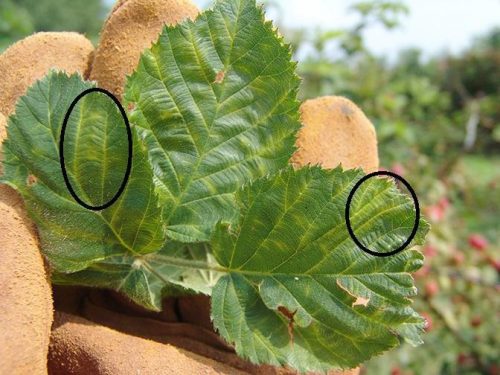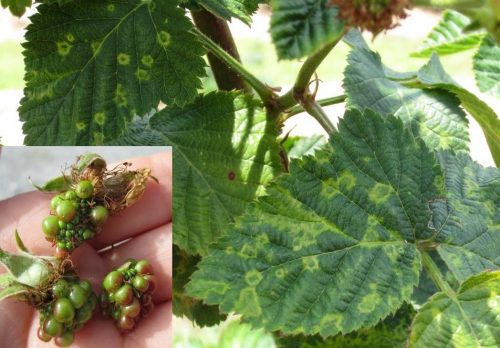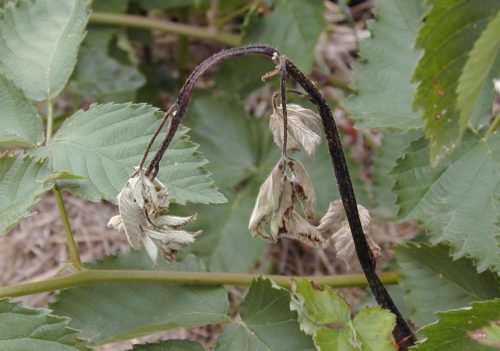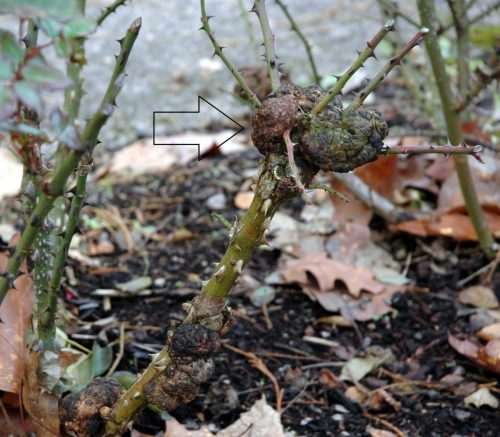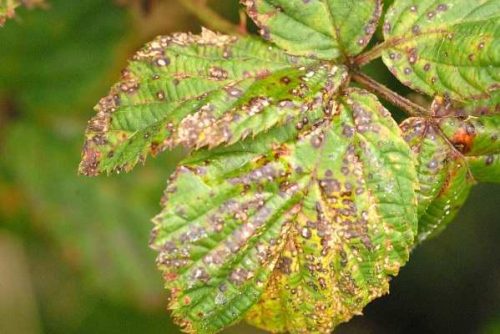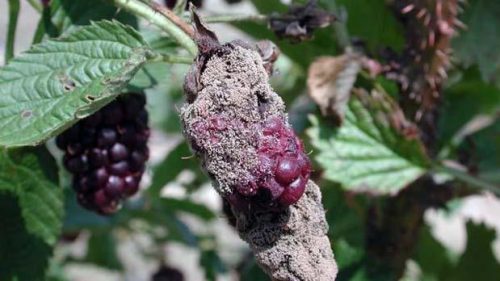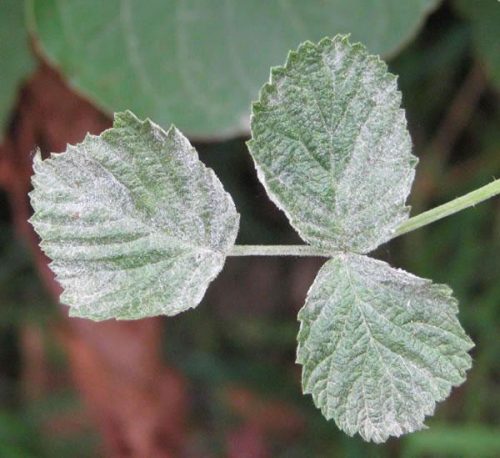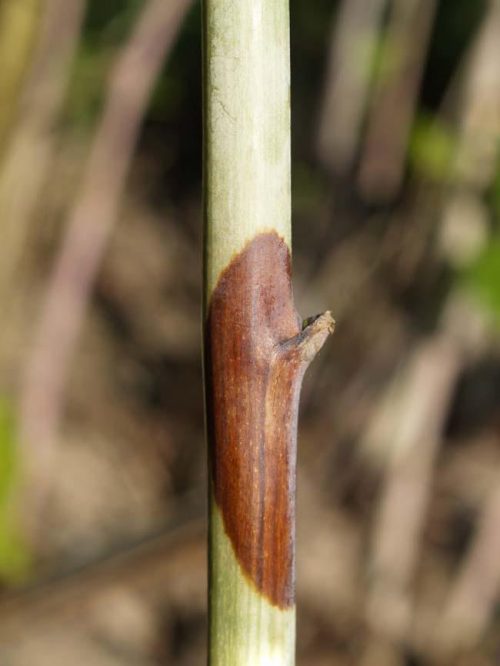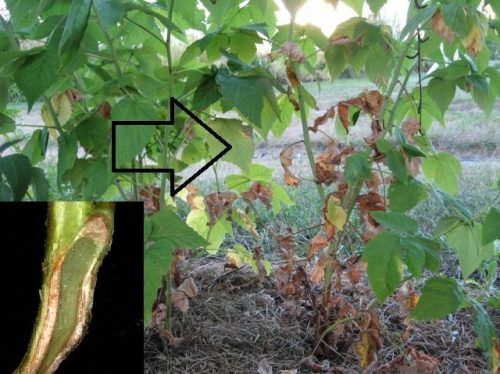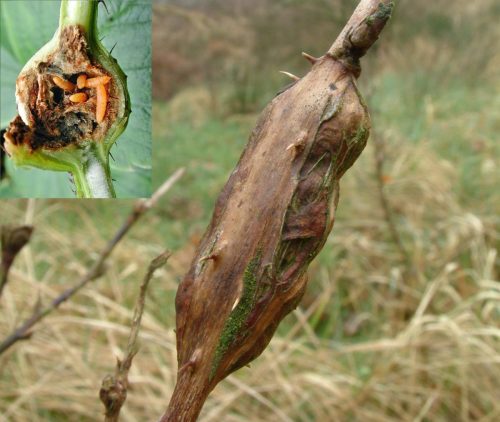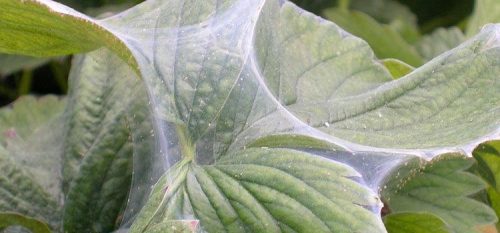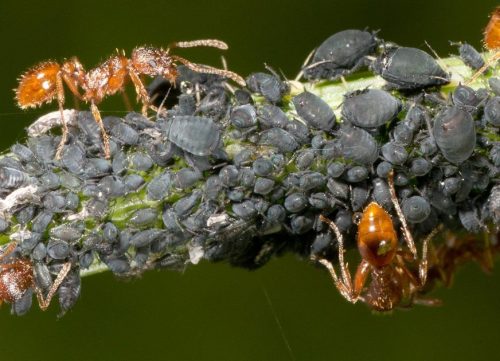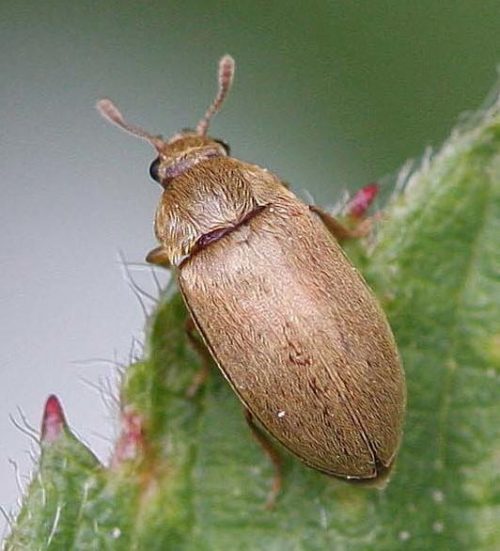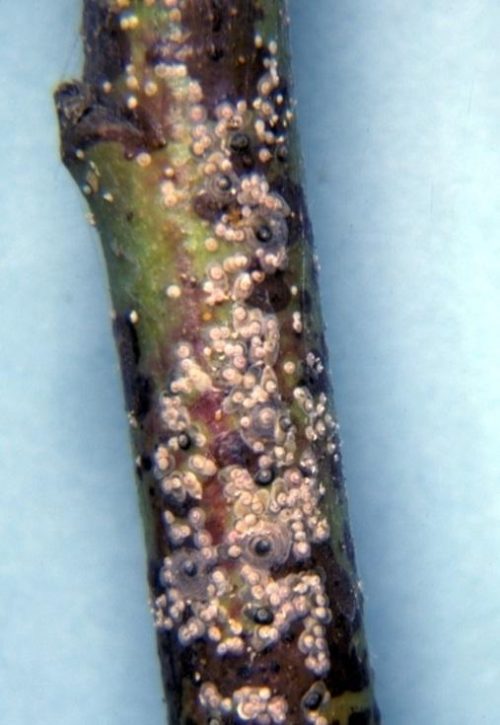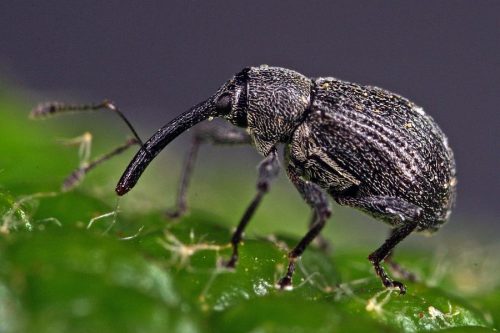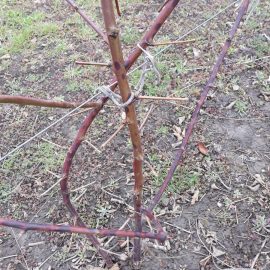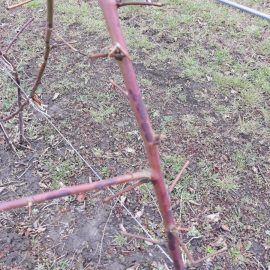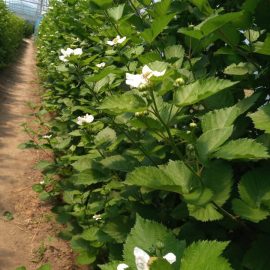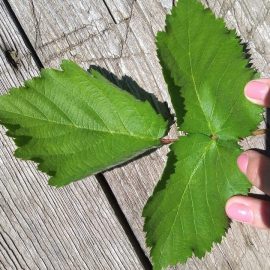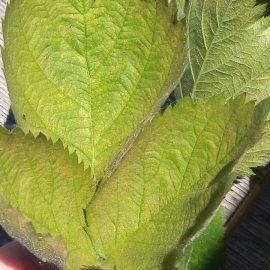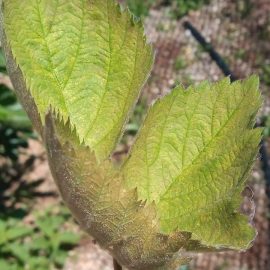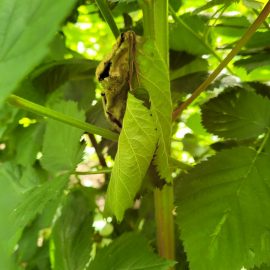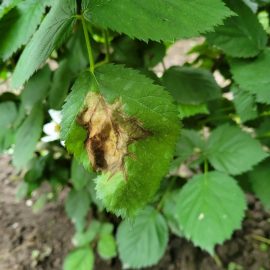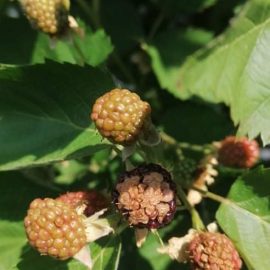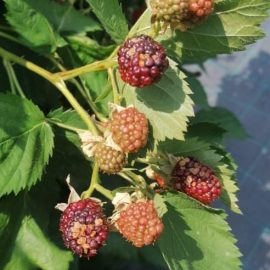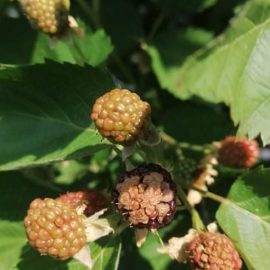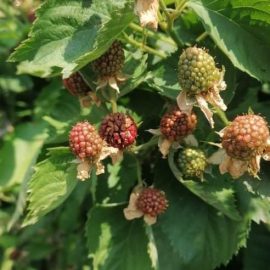Blackberry treatments, pest and disease control
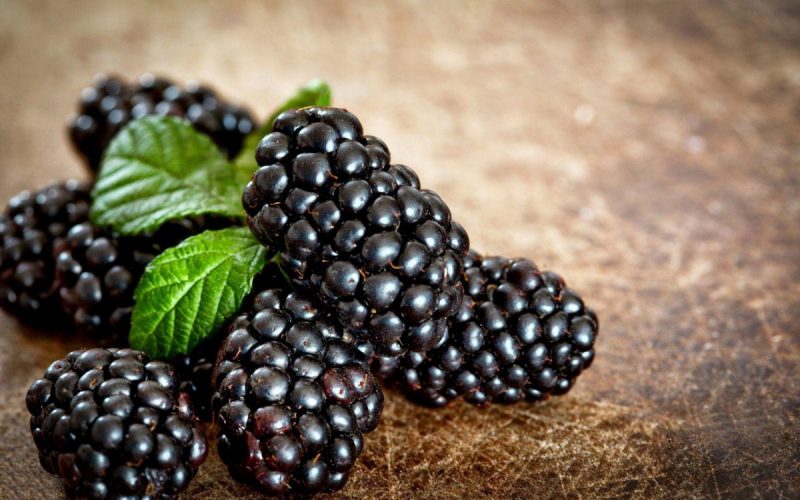
Blackberry (Rubus spp.) is a fruit-bearing shrub that grows spontaneously in many mountainous and hilly areas. Due to the nutritional properties of the fruit, this species has been adapted and cultivated. The blackberry shrub has erect or creeping branches. Blackberries are tasty polydrupa-type fruits and are eaten fresh or prepared in various forms (jam, syrup, etc.). Because of their complex mineral content, blackberries are recommended for people suffering from anemia, lung diseases, liver or bladder diseases. The fruit contains sodium, calcium, magnesium, iron, potassium, carbohydrates, protein, organic acids, and vitamins (A, D, C, B6, B-12).
The main diseases of blackberry shrubs
VIRUSES
Blackberry Yellow Vein Virus
A complex of viruses causes this disease. The first symptoms include yellowing of the leaf veins, and the plant dies in case of severe attack. Most of the time this disease causes growth stagnation. This virus is transmitted by nematodes and by propagation (cutting, grafting, etc.).
Prevention and control methods:
- proper soil preparation;
- using healthy planting material;
- removing attacked shrubs from the plantation;
- careful checking of seedlings before planting.
Tobacco ringspot virus
It is the most widespread virus attacking blackberry plants. The main symptoms are observed on the leaves: circular spots appear on them. The attacked tissues stop developing normally and the leaves become deformed. This virus also attacks the fruit, causing deformations. As a result of the attack, the shrubs stagnate in growth, production decreases significantly, and finally, the plants die. Pollen, seeds, and vegetative propagation transmit this virus. Aphids can also transmit this virus.
Prevention and control methods:
- careful checking of the cuttings before planting;
- removing attacked shrubs from the plantation;
- applying insecticides to keep aphid populations under control.
BACTERIOSIS
Fire blight (Erwinia amylovora)
The attack is visible on the shoots, flowers, and fruits. The tips of the leaves are brown, and dry, and curl into a hook shape, and in conditions of high atmospheric humidity, bacterial exudate appears on the surface of the attacked tissues. Erwinia amylovora is transmitted by this exudate, spread by pollinators, wind, water droplets, birds, etc. The bacterium is resistant to high temperatures and can survive in areas protected from sunlight for up to 12 months. Over winter, the bacteria survive in the affected tissues (buds, bark, shoots).
Prevention and control measures:
- cutting and burning of affected branches down to healthy tissue;
- chemical treatments with specific fungicides, applied after each rain.
Bacterial gall (Agrobacterium tumefaciens)
The emergence of the disease is favored by temperatures between 22 and 30 degrees Celsius and atmospheric humidity of ca. 80%. The bacterium enters the plant through wounds caused by nematodes, hail, etc. Tumors of different shapes and sizes develop on the roots and stems. In the beginning, they are small, white, and soft, and later they become woody and brown. The cells that make up these tumors are large and deformed. The bacterium can survive in the soil for many years and is spread by water, dust, and agricultural tools. The disease is favored by moist and compacted soils, excess nitrogen fertilizers, the presence of nematodes, etc. Light has an inhibitory effect.
Prevention and control measures:
- placing plants on light soils;
- tusing healthy seedlings;
- disinfecting tools and machinery;
- removing affected plants.
MYCOSIS
Rust of raspberry (Phragmidium rubi-idaei)
This disease occurs frequently in the blackberry crops. Yellow spots can be observed on the upper side of the leaves. The fungus fructifications are present on the underside: circular yellow-orange formations. Heavily affected leaves turn yellow and fall off.
Prevention and control measures:
- planting resistant blackberry varieties;
- burning the plant debris from the plantation;
- two sulfur-based treatments are recommended during the dormancy period;
- 2-3 treatments with specific fungicides during the vegetative season.
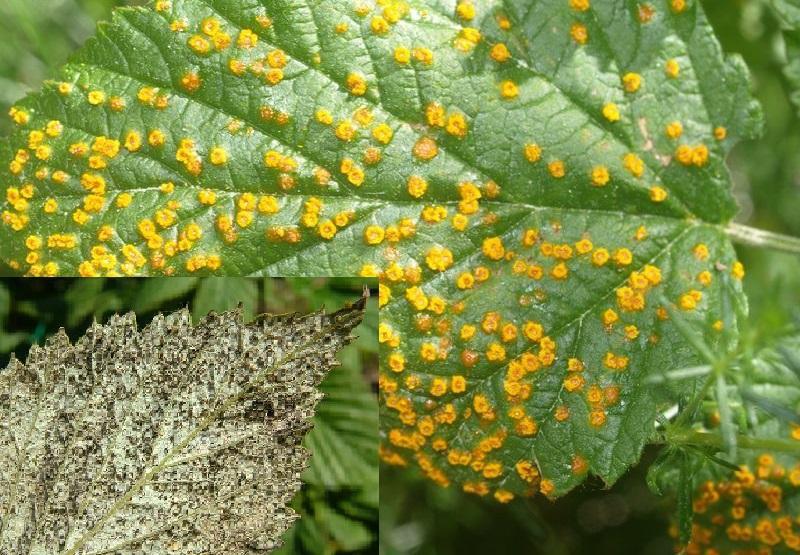
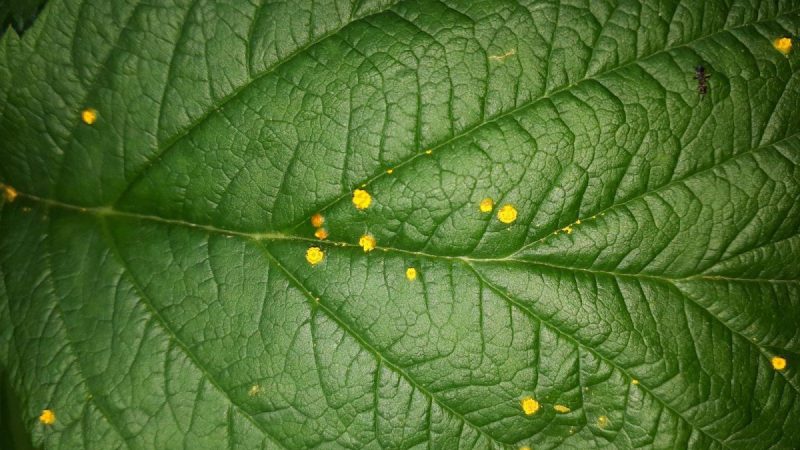
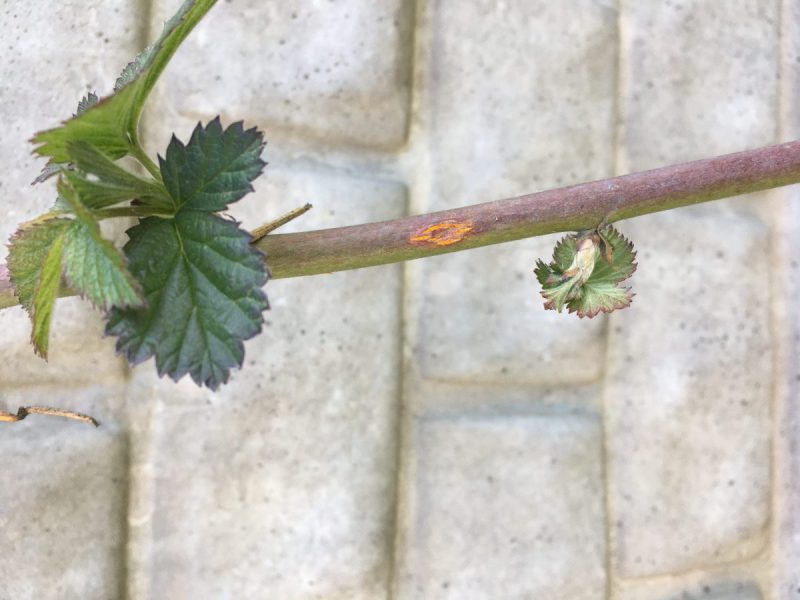
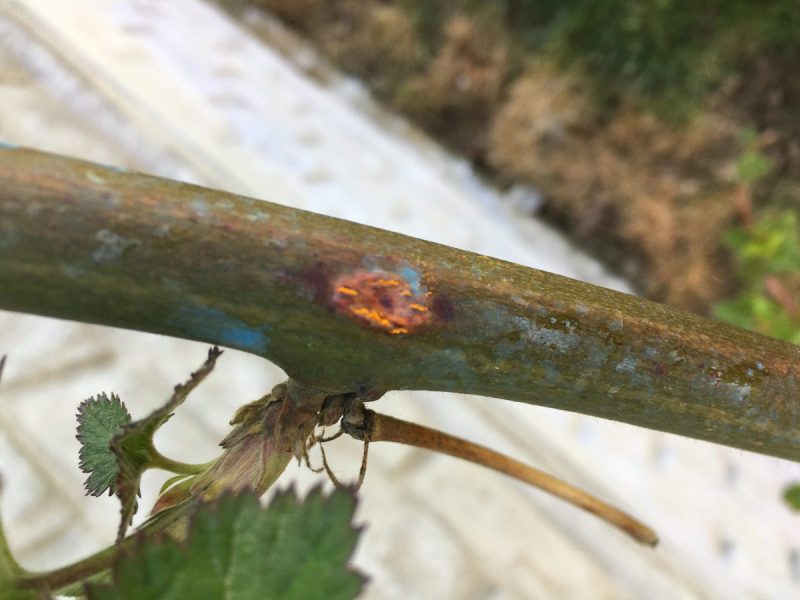
Recommended products
-
You can find products on a different store
Change Store -
You can find products on a different store
Change Store -
You can find products on a different store
Change Store -
You can find products on a different store
Change Store -
You can find products on a different store
Change Store -
You can find products on a different store
Change Store -
You can find products on a different store
Change Store -
You can find products on a different store
Change Store -
You can find products on a different store
Change Store -
You can find products on a different store
Change Store -
You can find products on a different store
Change Store -
You can find products on a different store
Change Store -
You can find products on a different store
Change Store -
You can find products on a different store
Change Store -
You can find products on a different store
Change Store -
You can find products on a different store
Change Store -
You can find products on a different store
Change Store -
You can find products on a different store
Change Store -
You can find products on a different store
Change Store -
You can find products on a different store
Change Store -
You can find products on a different store
Change Store -
You can find products on a different store
Change Store -
You can find products on a different store
Change Store -
You can find products on a different store
Change Store
Raspberry leaf spot (Sphaerulina rubi)
This disease is widespread in many countries with temperate climates. Circular, greyish-white spots (3-4 mm in diameter) appear on the leaves, bordered by a brownish-purple ring. The spots expand, merge, and become brown in time, and the leaves fall prematurely. The fungus overwinters on the plant debris from the soil surface and spreads by spores during the growing season.
Prevention and control measures:
- burning dried leaves and stems;
- improving air circulation by planting at recommended distances and by performing specific maintenance work (especially pruning);
- chemical treatments with specific fungicides.
Gray mold (Botrytis cinerea)
The emergence of the fungus is favored by high humidity, low air ventilation, and low light conditions. In rainy years, the damage caused by this fungus can affect up to 70-80% of the crop. The fungus lives on the plant debris from the soil surface, and its spores are transported to healthy plants by air drafts and water droplets. Specific symptoms can be observed on the aerial organs of the attacked shrub: some surfaces turn brown and become covered with a gray fuzz (representing the fungus fructification). Then, the affected organs rot. The attack on the stems occurs in rainy years and is manifested by dark brown spots. The disease evolves rapidly and can destroy the fruits or it can spread to neighboring plants. Gray mold can have a severe impact on production, even after harvest.
Prevention and control measures:
- planting resistant blackberry varieties;
- respecting the recommended planting distances;
- collecting and burning plant debris from the plantation;
- 3-4 chemical treatments in the following phases: green bud phase, white bud phase, flowering phase, and first fruit formation phase.
Recommended products
-
You can find products on a different store
Change Store -
You can find products on a different store
Change Store -
You can find products on a different store
Change Store -
You can find products on a different store
Change Store -
You can find products on a different store
Change Store -
You can find products on a different store
Change Store -
You can find products on a different store
Change Store -
You can find products on a different store
Change Store -
You can find products on a different store
Change Store -
You can find products on a different store
Change Store -
You can find products on a different store
Change Store -
You can find products on a different store
Change Store -
You can find products on a different store
Change Store -
You can find products on a different store
Change Store -
You can find products on a different store
Change Store -
You can find products on a different store
Change Store -
You can find products on a different store
Change Store -
You can find products on a different store
Change Store -
You can find products on a different store
Change Store -
You can find products on a different store
Change Store -
You can find products on a different store
Change Store -
You can find products on a different store
Change Store -
You can find products on a different store
Change Store -
You can find products on a different store
Change Store
Powdery mildew (Sphaerotheca macularis)
Symptoms of the attack can be seen on the shoots, leaves, and fruits, which are covered with a greyish-white fuzz. The margins of the leaves are twisted, and the attacked shoots remain thin, deform, become brown, and finally dry out. Young fruits become covered with the same powdery fuzz. They stop ripening and rot.
Prevention and control measures:
- planting resistant blackberry varieties;
- removing and burning the attacked shoots;
- chemical treatments with specific fungicides;
Recommended products
-
You can find products on a different store
Change Store -
You can find products on a different store
Change Store -
You can find products on a different store
Change Store -
You can find products on a different store
Change Store -
You can find products on a different store
Change Store -
You can find products on a different store
Change Store -
You can find products on a different store
Change Store -
You can find products on a different store
Change Store -
You can find products on a different store
Change Store -
You can find products on a different store
Change Store -
You can find products on a different store
Change Store -
You can find products on a different store
Change Store -
You can find products on a different store
Change Store -
You can find products on a different store
Change Store -
You can find products on a different store
Change Store -
You can find products on a different store
Change Store -
You can find products on a different store
Change Store -
You can find products on a different store
Change Store -
You can find products on a different store
Change Store -
You can find products on a different store
Change Store -
You can find products on a different store
Change Store -
You can find products on a different store
Change Store -
You can find products on a different store
Change Store -
You can find products on a different store
Change Store
Spur blight of raspberry (Didymella applanata)
It is also known as the ‘spur canker of raspberry’, and it causes significant damage in rainy springs. Large, brownish-purple spots appear on the young shoots at the end of spring and the beginning of summer. Attacked branches dry out from the tip to the base, and the attacked bark peels off. The disease progresses, and small, blackish-brown spots appear on the surface of the attacked tissues, representing the fungus fructification. The attack on the leaves manifests itself as large, colorful spots that appear along the main veins. The axillary buds at the base of the leaves turn brown and dry out. The fungus spreads through vegetation via spores carried by rainwater and wind.
Prevention and control measures:
- using healthy planting material;
- weed control;
- improving air circulation by appropriate prunings;
- rational fertilization;
- removing and burning dry branches;
- chemical treatments with specific fungicides.
Verticillium wilt (Verticillium sp.)
The fungus infests the roots and the plant vessels, causing them to block. This leads eventually to wilting and drying of the affected plants. Initially, plants may show symptoms of slight wilting during the day, followed by an apparent recovery in the evening and at night. As the disease progresses, the leaves open up in color, turn yellow, and fall off, starting at the base of the shoot and progressing to the tip. When cutting across an affected stem, you can see the browned vessels. The fungus can enter the plant through various wounds caused by nematodes, insects, and technological works.
Prevention and control measures:
- avoiding planting in fields where vegetables have been grown;
- using resistant blackberry varieties;
- collecting and destroying plant debris from the plantation;
- removing infested plants from the crop;
- chemical treatments applied to the soil with specific fungicides.
The main pests of blackberry shrubs
Blackberry stem gall midge (Lasioptera rubi)
Adults have a 1.5-3 mm long, dark body, and the larvae are reddish. The insect develops one generation per year. In May-June, females lay eggs in clusters (about 15 eggs in a cluster) on the shoots, near the flower buds. After hatching, the larvae penetrate the stem, forming globular galls. The galls are 3-4 cm long and have a 1.5-2 cm circumference. In July-August, these galls are filled with larvae and can be easily observed. At first, the galls are green, then they turn light brown and become woody. After the attack, the growth and fruit formation is inhibited. Often, the stem of the blackberry breaks at the bottom of the gall.
Control methods:
- removing and destroying infested stems;
- insecticide treatments when adults appear.
Mites
They are small insects that cause damage to many plant species in protected areas or the field. The first attacks can appear in spring, but significant damage to crops occurs in summer when temperatures are high. They can develop 7-8 generations per year and overwinter as eggs or adults. Mites are usually located on the underside of leaves where they feed. The first symptoms are visible on the upper part of the leaves, which show small, chlorotic spots. After intense feeding, the spots merge and the leaves turn whitish, then brown. A fine web is observed on the attacked leaves, within which individuals at all stages of development live. Besides leaves, mites can also feed on fruits.
Control methods:
- chemical treatments with specific products.
Recommended products
-
You can find products on a different store
Change Store -
You can find products on a different store
Change Store -
You can find products on a different store
Change Store -
You can find products on a different store
Change Store -
You can find products on a different store
Change Store -
You can find products on a different store
Change Store -
You can find products on a different store
Change Store -
You can find products on a different store
Change Store -
You can find products on a different store
Change Store -
You can find products on a different store
Change Store -
You can find products on a different store
Change Store -
You can find products on a different store
Change Store -
You can find products on a different store
Change Store -
You can find products on a different store
Change Store -
You can find products on a different store
Change Store -
You can find products on a different store
Change Store -
You can find products on a different store
Change Store -
You can find products on a different store
Change Store -
You can find products on a different store
Change Store -
You can find products on a different store
Change Store -
You can find products on a different store
Change Store -
You can find products on a different store
Change Store -
You can find products on a different store
Change Store -
You can find products on a different store
Change Store
Aphids
They are polyphagous species that migrate from one plant to another, causing damage to many crop species or wild species. The aphids form colonies on the underside of leaves and as a result of the attack the leaves curl, twist, turn yellow, and dry out. They are mainly found on young tips and can also attack flowers. Attacked plants stagnate, turn yellow, and become susceptible to fungal attack. The presence of aphids is followed by their sweet droppings covering the leaves, forming the so-called “honeydew”, which allows saprophytic fungi to settle and form sooty mold.
Control methods:
- chemical treatments with specific insecticides.
Recommended products
-
You can find products on a different store
Change Store -
You can find products on a different store
Change Store -
You can find products on a different store
Change Store -
You can find products on a different store
Change Store -
You can find products on a different store
Change Store -
You can find products on a different store
Change Store -
You can find products on a different store
Change Store -
You can find products on a different store
Change Store -
You can find products on a different store
Change Store -
You can find products on a different store
Change Store -
You can find products on a different store
Change Store -
You can find products on a different store
Change Store -
You can find products on a different store
Change Store -
You can find products on a different store
Change Store -
You can find products on a different store
Change Store -
You can find products on a different store
Change Store -
You can find products on a different store
Change Store -
You can find products on a different store
Change Store -
You can find products on a different store
Change Store -
You can find products on a different store
Change Store -
You can find products on a different store
Change Store -
You can find products on a different store
Change Store -
You can find products on a different store
Change Store -
You can find products on a different store
Change Store
Raspberry beetle (Byturus tomentosus)
This species also attacks blackberry shrubs, among other species. The adult has an elongated, greyish-black, hairy body. The larva is brownish-brown or yellowish and has a brown spot on each body segment. It has one generation per year or once every two years and overwinters as an adult or larva in the topsoil. Both adults and larvae cause damage. Adults appear in spring, gnaw young leaves, bore flower buds, and feed on floral organs. The females lay eggs on the flowers and the larvae feed on the fruit. Attacked fruits are small, dark, and rotten.
Control methods:
- shaking the shrubs and destroying the beetles;
- gathering the attacked fruit;
- applying two treatments (one before raspberry flowering and the second after flowering).
The San Jose scale (Quadraspidiotus perniciosus)
It is a polyphagous species, attacking more than 200 plant species. It has 1-3 generations per year and overwinters in the lava stage on the bark of affected species. Females and larvae spread to all organs of affected plants, including fruit, and feed on the plant sap. In case of a massive attack, the shields protecting the insect bodies overlap and suffocate the shrubs. They stagnate in growth, and after 2-3 years they wither.
Control methods:
- applying dormancy period treatments with horticultural oil-based products;
- chemical treatments with specific insecticides, during the vegetative growth period.
Recommended products
-
You can find products on a different store
Change Store -
You can find products on a different store
Change Store -
You can find products on a different store
Change Store -
You can find products on a different store
Change Store -
You can find products on a different store
Change Store -
You can find products on a different store
Change Store -
You can find products on a different store
Change Store -
You can find products on a different store
Change Store -
You can find products on a different store
Change Store -
You can find products on a different store
Change Store -
You can find products on a different store
Change Store -
You can find products on a different store
Change Store -
You can find products on a different store
Change Store -
You can find products on a different store
Change Store -
You can find products on a different store
Change Store -
You can find products on a different store
Change Store -
You can find products on a different store
Change Store -
You can find products on a different store
Change Store -
You can find products on a different store
Change Store -
You can find products on a different store
Change Store -
You can find products on a different store
Change Store -
You can find products on a different store
Change Store -
You can find products on a different store
Change Store -
You can find products on a different store
Change Store
Strawberry blossom weevil (Anthonomus rubi)
Adults have a black body with fine, greyish pubescence. Longitudinal stripes can be observed on their wings. They overwinter as adults under the fallen leaves, or in the topsoil. In spring, adults feed on vegetative and flowering buds. Females lay their eggs in the flower buds, interrupting the sap circulation so that the bud does not develop normally. Larvae develop inside the buds and feed on the floral organs.
Control methods:
- collecting and destroying affected flower buds;
- collecting and destroying the plant debris;
- applying chemical treatments with specific insecticides in spring, when adults appear.














































































































































































































































































































































































































































